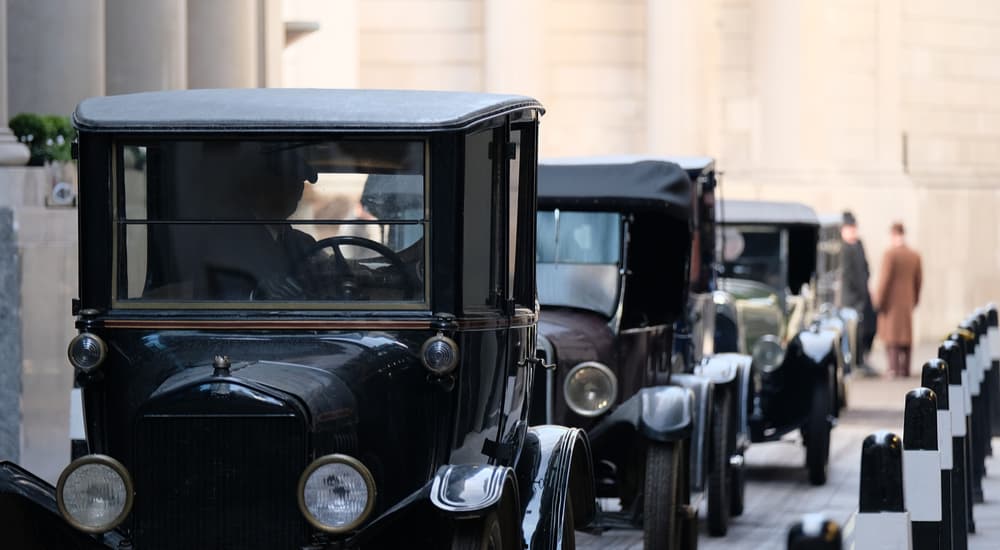What do cruise control, four-wheel antilock brakes, high-compression engines, and key-start ignition have to do with each other? They were all introduced by Chrysler. At a time when America’s major automakers stuck with the status quo, Chrysler positioned itself at the helm of innovation and proudly adopted new technology like cruise control and antilock brakes. This meant that your local Chrysler dealership was a hotbed of premium models laden with cutting-edge features.
Chrysler’s willingness to adopt new technology earned the company a place among the “Big Three” automakers in America and challenged competitors to do the same in a healthy competition where drivers reaped the benefits. Surprisingly, however, this isn’t typically what comes to mind when people think of Chrysler today. The automaker’s ebb and flow of financial success and numerous mergers often overshadow Chrysler’s remarkable journey of advancing the American automotive industry. This is the history that deserves a spotlight, and it all starts at the very beginning of the Chrysler brand.
The Man Behind the Name: Walter Chrysler
The son of a locomotive engineer from Kansas, Walter Chrysler inherited his father’s knack for machinery and got his start with the Santa Fe Railroad as a machinist before climbing the ladder as a master mechanic and superintendent in the late 1890s. Chrysler’s interests shifted in 1908 when he purchased a Locomobile touring car after attending the Chicago Auto Show. Instead of driving the vehicle, he disassembled it and studied how it worked.
Fascinated by automobiles, Chrysler continued tinkering and landed a job with Buick, where he cut production costs and later served as president. After a brief retirement in 1919, he was hired to bring Willys-Overland Motor Company out of its financial crisis, earning a jaw-dropping salary of $1 million. Reducing the company’s debt, he attempted to take over the company without success. Undeterred, he started buying stock in the failing Maxwell Motor Company instead. Chrysler had a plan and hired the best engineers to bring that plan to life.

The Journey Begins with the First Chrysler
Chrysler left everyone amazed in 1924 when he unveiled his first vehicle at the New York Auto Show. The model was a true masterpiece and set a precedent for the future Chrysler brand. Its 3.3-liter straight-six engine featured an oil filter, a carburetor air filter that also worked as a silencer, pressure lubrication, and a 4.7:1 compression ratio, the latter of which was unheard of at the time. Its power was also remarkable, producing 68 horses at a time when Ford models only delivered 40 horsepower.
Moving beyond the engine, the 1924 Chrysler B-70 was filled with innovative features like four-wheel hydraulic brakes that replaced the popular mechanical brakes on other models. It also came with shock absorbers, which meant a smoother ride and the capability of reaching up to 75 mph. There was no other vehicle like it.
The success of the first Chrysler prompted the savvy businessman to reorganize the Maxwell Motor Company into the Chrysler Corporation in 1925. The same year, the company led the industry with the development of rubber engine mounts and a vibration damper to improve the handling and ride quality of its vehicles. By 1928, Americans were introduced to the Plymouth and DeSoto brands, both of which were wildly popular.
The 1930s brought further advancements like the Floating Power system that mounted the engine to the automobile’s chassis to align its center of gravity better and reduce vibration. The outbreak of World War II forced Chrysler’s attention to aid in the war effort, but the automaker came back full throttle by the end of the decade and introduced innovations like the key-start ignition switch. First featured on the 1949 Chrysler, the switch eliminated the need to push a separate button to start the vehicle and allowed drivers the convenience of simply turning a key.
Taking It All in Stride: Innovation and Improvement
Chrysler shocked the industry again in 1951 with the introduction of the hemispherical cylinder head, which we know today as the Hemi engine. The Hemi delivered more power and greater efficiency (and still does today), making Chrysler models more popular throughout the decade. This popularity ushered in a new era of innovations and improvements that impacted everything from Chrysler’s air conditioning system to its suspension design. Chrysler introduced the industry’s first cruise control system, aptly named Auto-Pilot, and made improvements to automotive air conditioners by using outside air to make them more efficient and faster to cool.
Throughout the late 1950s and 1960s, Chrysler flourished as one of the biggest automakers in the country. It developed and debuted the first alternator on the 1960 Plymouth Valiant and saw the component standardized throughout the industry. Although credited with designing the swiveling seat, the automaker eventually discontinued the seat and turned its attention to vehicle design. Seeing the benefits of unibody construction, Chrysler was the first American manufacturer to adopt the design and reaped the benefits with a lighter and quieter lineup. With Chrysler models already offering exceptional ride quality thanks to ongoing engineering improvements, this was the icing on the cake.
The 1970s marked a significant shift for Chrysler as the automaker fell into a financial abyss, facing bankruptcy and eventually requiring a government bailout. While innovation frequently took a backseat to rising financial concerns, there were several innovations throughout the decade that revealed Chrysler’s innovative roots. For example, the 1971 Imperial introduced four-wheel antilock brakes to the industry, while the 1972 Chrysler debuted the industry’s first electronic ignition, improving engine reliability and requiring fewer repairs and tune-ups. The new ignition was later adopted by Chrysler’s Big Three competitors – General Motors and Ford.
Despite a government bailout on the horizon, Chrysler continued to advance with its designs. The 1978 Plymouth Horizon and Dodge Omni showcase as much and were the first American cars to feature a transverse engine. They were also the first models in America to use a multifunction turn signal, moving the high-beam controls and windshield wiper control from the dash and floor to a stalk behind the steering wheel – a design that is still used today.
Bailouts, Mergers, and Beyond
With the government signing a $1.5 billion loan for Chrysler in 1980, the automaker was financially back on its feet and reported record profits over the next several years. Chrysler paid off the loan early in 1983 and introduced its first minivan, which sent profits soaring even higher at the dawn of the 1990s. For the first time since 1957, Chrysler reached an all-time high in 1996, only to merge with Daimler-Benz in 1998 and face another round of setbacks and plant closures in the new millennium. The merger marked the first of several throughout the next two decades, as well as an ebb and flow of massive profits and drastic losses that shaped Chrysler’s part in America’s modern automotive landscape.
While this tumultuous financial history is often the headline of every story, it shouldn’t be the only part of Chrysler’s story. Chrysler’s innovation is a story that deserves to be told, especially when you consider the many risks that Chrysler took in adapting cutting-edge technology like cruise control and the key-start ignition. Chrysler was the first to adopt these features, which meant other automakers weren’t yet ready to take those risks or didn’t have the technology to do so.
With Chrysler’s innovation in mind, think about the adage, “With great risk often comes great reward.” This puts a new perspective on Chrysler’s history and its impact on the automotive industry. Chrysler’s commitment to delivering cutting-edge technology ahead of its time was a great risk that the automaker was willing to take time and time again for the sake of advancing the industry and meeting the evolving demands of drivers from coast to coast.





